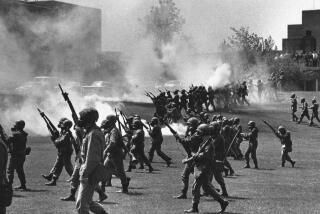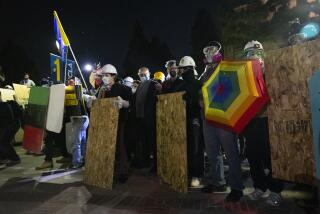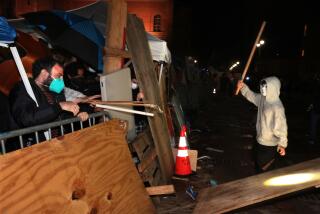Student-run media meet challenge
BLACKSBURG, VA. — The news marathon began shortly after 7 a.m. Monday, as unofficial reports of the first Virginia Tech shootings began trickling in through e-mails, text messages and cellphone calls.
During the course of that day and through the next, student reporters fanned out to cover the shattering events that overwhelmed the campus -- interviewing students, teachers, school administrators, police officers and hospital workers.
Collegiate Times editor-in chief Amie Steele became a staple on CNN, explaining details of the shooting. Reporters for the student-run newspaper churned out stories even as phones failed, police evacuated them from their offices in the student center, and their website crashed as it was discovered by readers the world over.
“We knew there was going to be some kind of reliance on us, and we couldn’t let people down,” said former sports editor Joe Kendall, 21, a political science major from Ashburn, Va., who had taken over only that morning as the paper’s managing editor.
By 6 a.m. Tuesday, when the paper went to bed, about a dozen bleary-eyed staffers had a string of online scoops and their most anticipated print edition ever -- a 16-page newspaper with a press run 1,000 more than its usual 14,000. It hit newsstands just as Kendall returned to the office after a quick nap.
The banner headline: “Heartache.”
As major news outlets scrambled to learn about the Virginia Tech shooter, the wounded and the dead, they found themselves scooped by Virginia Tech’s student-run media: The Collegiate Times newspaper and website, collegemedia.com; the web-only news site, planetblacksburg.com; and radio station WUVT-FM.
On Tuesday, the student staffs continued to use the communications tools favored by many students to bolster their news gathering: social networking websites like facebook.com, online forums and text messaging.
The Collegiate Times was founded 104 years ago as a sports newspaper, and although its reach expanded during the 1950s, it’s still heavily sports-oriented. Operated independently from the university as a nonprofit, it is published Tuesday through Friday and distributed free across campus.
Until this year, the biggest local headlines involved football games and standout players Michael and Marcus Vick. Student staff, who are paid, started the paper’s website about eight years ago. It typically drew about 2,000 to 3,000 visitors a day.
By Tuesday, the site had about 168 visitors a minute. About 15 staff members were rushing to update the site about every 15 minutes with news of the convocation, shooting investigation and candlelight vigil plans.
“We’re getting like 10 billion phone calls, everyone from Al Jazeera to tiny radio stations in Iowa,” Kendall said.
The paper’s scoops included eyewitness accounts of the shootings, interviews with a classmate of the shooter and a list of victims’ names that was posted late Tuesday. A reporter was one of the first to question administrators about why they didn’t warn students during the two hours between the two shootings Monday morning.
The paper’s main rival on campus is planetblacksburg.com, which was founded in a computer lab a few years ago by former Collegiate Times reporter Andrew Mager, 22, of Downingtown, Pa., with a college advisor and volunteer staff. On Monday, its staff hurried to the shooting scenes, gathered eyewitness accounts and then mined facebook pages for additional contacts, eventually creating an online wall for mourners to post comments.
“We felt like that was a service where people could go online in their dorm rooms and look at it. They can get the stuff from the press conferences anywhere,” said editor Courtney Thomas, 22, of Midlothian, Va., whose friend was shot in the leg during the shooting in Norris Hall. Thomas was interviewed by the BBC and Newsweek on Tuesday and kept reporting while fielding requests for freelance magazine stories.
The website, which usually receives 5,000 to 6,000 hits a day, saw 1 million Monday, with about 40,000 of those visitors coming from facebook sites, Mager said. In response, staff started updating the site at least hourly instead of once or twice a day.
“We’re focusing on the use of technology and the facebook response that’s growing all the time,” Thomas said.
About noon, staff called Virginia state police to their computer lab to report a threat they found while investigating an online forum that they believed was written by the shooter.
At the student radio station, business manager William Glynn, 20, of Richmond, Va., said announcers are careful to filter information about the shootings, relying on university statements and reports they can corroborate.
“We just tried not to release anything that wasn’t confirmed,” he said. “It’s just professional integrity.”
Among those wounded in the shooting was a senior who worked at the station. Aydin Akyurtlu, the station’s 21-year-old news director, said the wounded student seemed to be in good spirits Tuesday and “the doctors say he’ll make a full recovery.”
At the Collegiate Times, reporter Saira Haider of Centreville, Va., learned Monday that a classmate and good friend had been killed in the shooting. Haider, 21, planned to attend a campus candlelight vigil Tuesday night -- but as a reporter.
“I don’t want to be biased -- I just want to report,” said Haider, a communications and history major who has spent three years on the paper. But she conceded that at Virginia Tech these days, “It is kind of hard to separate the two -- the emotional side and the news side.”
*
molly.hennessy-[email protected]
Times staff writer Adam Schreck contributed to this report
More to Read
Sign up for Essential California
The most important California stories and recommendations in your inbox every morning.
You may occasionally receive promotional content from the Los Angeles Times.











